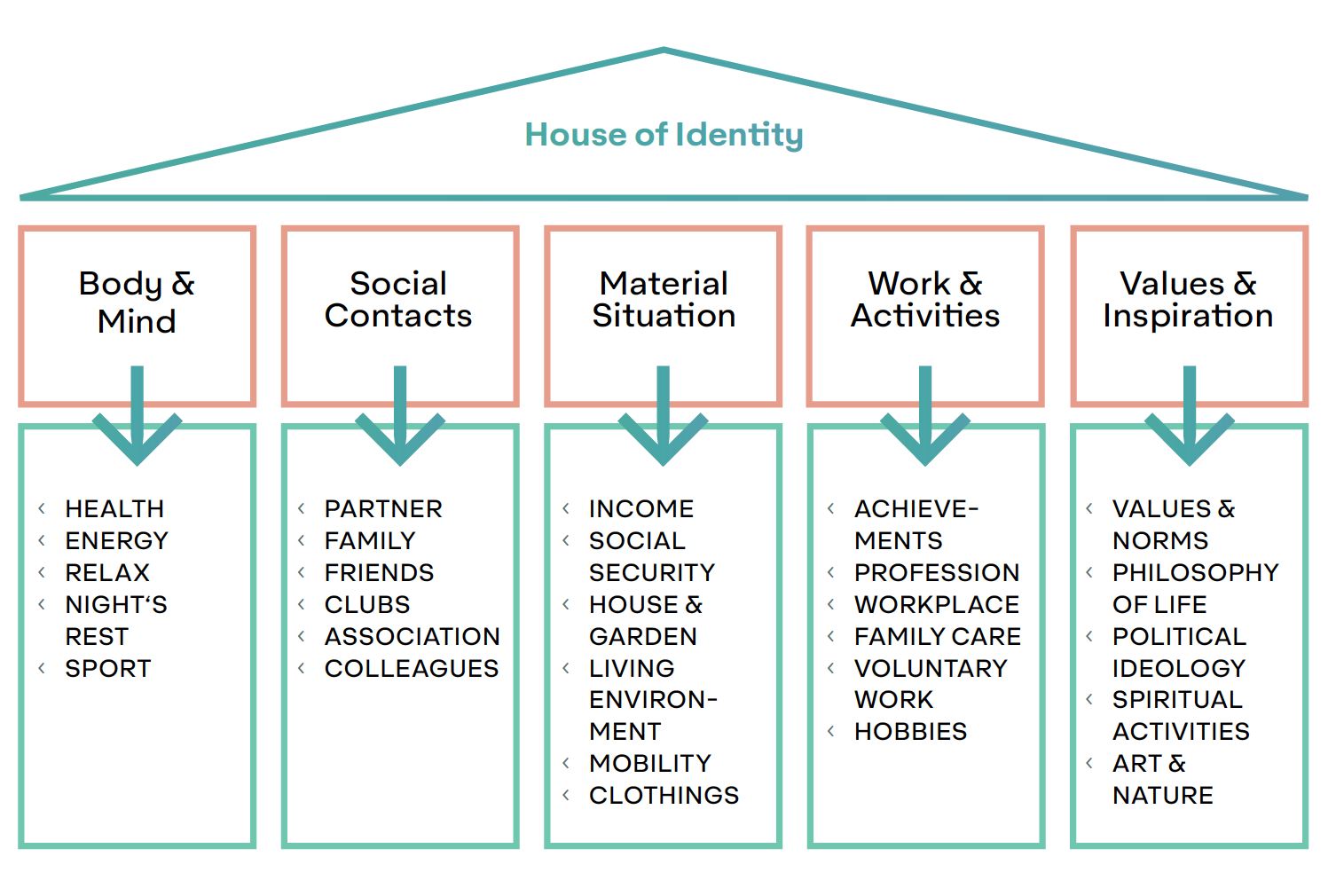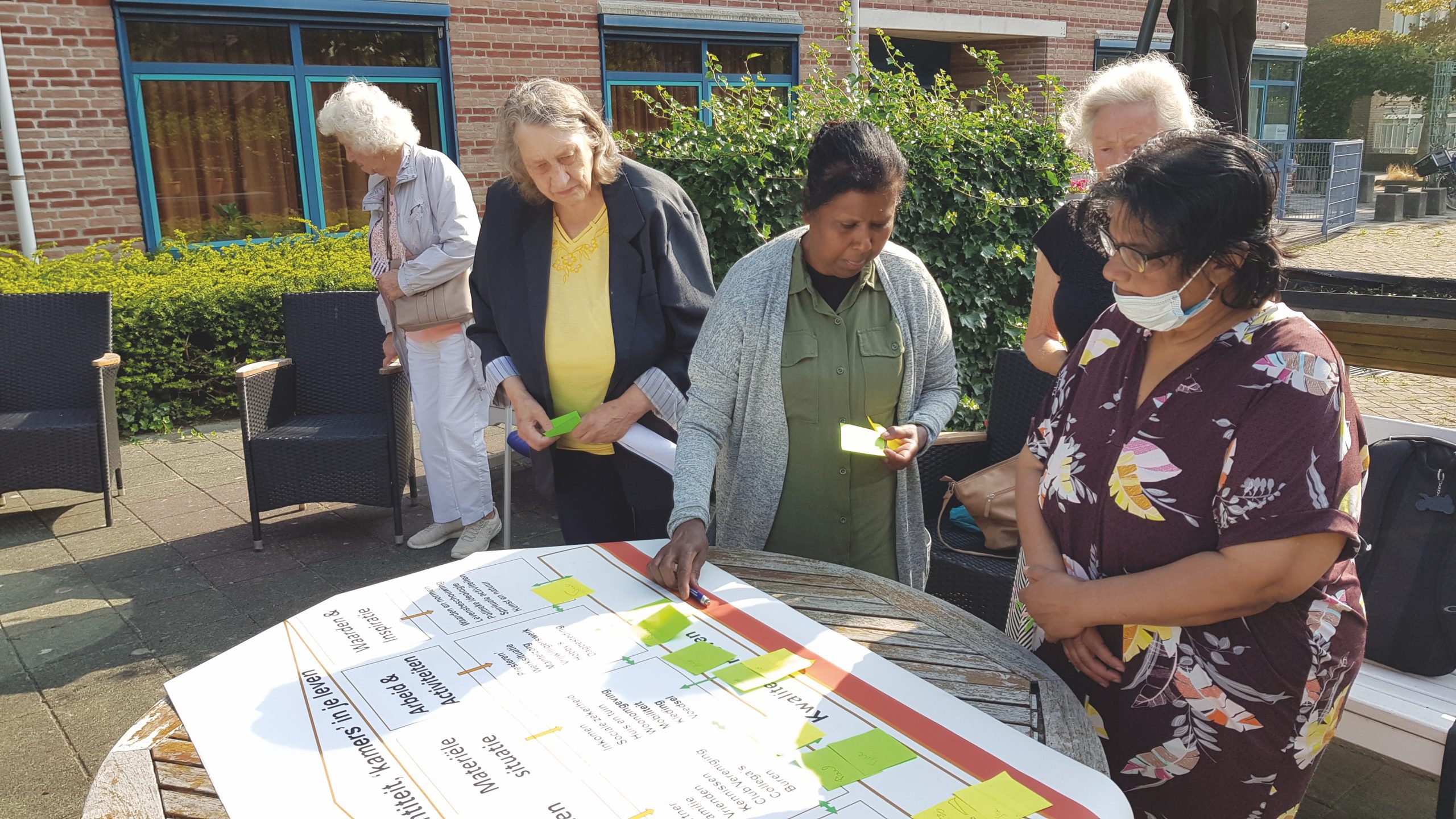
Source: Figure based on Huis van de Identiteit, Houben, P. (2009). Interactief levensloopbeleid. Amsterdam: SWP.
A very inspiring method tested in the neighbourhood groups was the “House of Identity”. The basic principle is “taking a broad look at your situation and your environment”. We are not used to this, often busy with only a small piece of the puzzle. The result is that potentially important sources of growth and strength are missed. The concept defines five basic life domains, in which people develop throughout their lives and become who they are. The five life domains together form the “house of identity” (Petzold, Houben, 2002, 2009, Van Gennip, 2009.) The figure below visualises this. It is a house with five rooms.
What are these five rooms about?
Body and mind
The “Body and mind” room deals with subjects such as movement, sexuality, appearance, muscle strength and mental well-being. The body and the psyche can be threatened; it is important to maintain physical and mental health. Examples of questions people may ask themselves are: Do I eat healthily? Do I exercise enough? Can I relax? Am I satisfied with my memory? Can I use modern media?
Social contacts
The social contacts room represents the social network, the relationships within which people live, such as family, friends, neighbours and associations. Here people ask themselves questions such as: Do I ever feel lonely? Do I have nice contacts? Do I experience support? Do I give support?
Material situation
In the material situation room, the subjects are income, a roof over one’s head, a home with sufficient comfort and a safe environment. The questions are: Do I have a suitable home? Do I live in a nice neighbourhood? Do I use the services to which I am entitled? Am I sufficiently mobile to be able to participate in society?
Work and activities
The room for work and activities is the place to start talking about the things that people undertake. Think of (voluntary) work, “having something to do”, being creative. A good theme is generativity (Erikson et al. 1971).1 Generativity is the will to produce something, to leave something behind that is of value to other generations. What can I contribute? Do I want/need a paid job/work? Is volunteering something for me? Am I there for my neighbours when they need me and are they there for me? How do I shape my role as an informal carer: can I still manage or is there a risk of overburdening?
Values and Inspiration
The values and inspiration room is about having ideas and values that give you spiritual support or that you want to realise during your life. Examples of questions are: What do I find important? From what do I derive meaning? Does religion still inspire me? What do I see when I look back at my life? Do I enjoy art and perhaps practice it actively?
A good conversation about “participation and meaning” touches all areas of life.
In all these domains, participants in the dialogue can ask themselves:
Don’t shut yourself up in one room.
People who experience a deficit in one of these rooms sometimes search for a long time for improvement within the same room. They lock themselves up in one room. An illness is diagnosed, and the idea is often that only the doctor can solve it. Someone becomes unemployed and looks for years – often in vain – for exactly the same job with the same salary. Someone finds themselves alone and puts all their efforts into finding a new partner. In this way, people often “muddle through” in vain, taking too narrow a view of their own options.
In the Dreamlike Neighbourhood groups in The Hague, working with the House of Identity has inspired many different subjects for further discussion. Subjects such as sleeping badly, assertiveness when visiting doctors, activities in the neighbourhood, how the health insurance system works, becoming digitally stronger, etc.
The method encourages looking for new possibilities around the question of participation and significance in the broadest possible way.

In the Hague, participants in the neighbourhood groups learned from each other by exchanging their dreams and wishes.
Photo © Loes Hulsebosch
